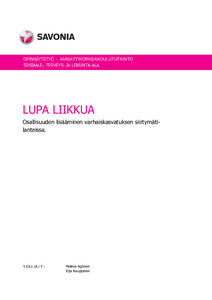Lupa Liikkua
Agonen, Helena; Erja, Kauppinen (2021)
Agonen, Helena
Erja, Kauppinen
2021
All rights reserved. This publication is copyrighted. You may download, display and print it for Your own personal use. Commercial use is prohibited.
Julkaisun pysyvä osoite on
https://urn.fi/URN:NBN:fi:amk-2021111120094
https://urn.fi/URN:NBN:fi:amk-2021111120094
Tiivistelmä
Abstract
The plan for early childhood education includes the daily exercise recommendation. The goal for adding more functionality and children’s active participation in kindergarten work is included. Pedagogical guidance situations need new child orientated and participatory practises that increase children’s participation and enhance active learning. Pedagogically planned guidance is a part of the development of continuing quality of early childhood education, along with the daily routine through which early support can be offered and the phenomenon of alienation of young children can be prevented. The client of the thesis is Paloisten Day Care Center.
The thesis is a development study whose goal is to develop a child oriented and participatory practise for the transitions in kindergarten. A new guidance practise was developed, in which children’s active participation and the recommendation for daily exercise was included, according to the early childhood education plan. We designed cards for a group of children, ages 4 to 5. The cards reflected the days of the week and were illustrated with exciting movements and creative expressions. The names of the kindergarten groups and different fairy tale characters were used in the illustrations. The visual appearance was executed in collaboration with the advertisement office DesingbyTiitu. The goal for the transition practises was to strengthen the interaction between a child and an adult. The development process was made using the linear model. The process can be divided into four stages: goal setting, planning, execution and evaluation.
Feedback was gathered after a two-week trial period. The staff of the kindergarten was sent a feedback form, in which they documented the categories that worked and the categories that still needed improvement. We collected feedback from childen by using interviews and emoticons. As a result of the development study, the cards increased children’s active participation. The guidance was seen as functional, the cards were easy to use and could be applied to a wider-scale guided activity in kindergarten work. The child orientated activity and active participation was significantly increased in the transitions of the kindergarten.
The plan for early childhood education includes the daily exercise recommendation. The goal for adding more functionality and children’s active participation in kindergarten work is included. Pedagogical guidance situations need new child orientated and participatory practises that increase children’s participation and enhance active learning. Pedagogically planned guidance is a part of the development of continuing quality of early childhood education, along with the daily routine through which early support can be offered and the phenomenon of alienation of young children can be prevented. The client of the thesis is Paloisten Day Care Center.
The thesis is a development study whose goal is to develop a child oriented and participatory practise for the transitions in kindergarten. A new guidance practise was developed, in which children’s active participation and the recommendation for daily exercise was included, according to the early childhood education plan. We designed cards for a group of children, ages 4 to 5. The cards reflected the days of the week and were illustrated with exciting movements and creative expressions. The names of the kindergarten groups and different fairy tale characters were used in the illustrations. The visual appearance was executed in collaboration with the advertisement office DesingbyTiitu. The goal for the transition practises was to strengthen the interaction between a child and an adult. The development process was made using the linear model. The process can be divided into four stages: goal setting, planning, execution and evaluation.
Feedback was gathered after a two-week trial period. The staff of the kindergarten was sent a feedback form, in which they documented the categories that worked and the categories that still needed improvement. We collected feedback from childen by using interviews and emoticons. As a result of the development study, the cards increased children’s active participation. The guidance was seen as functional, the cards were easy to use and could be applied to a wider-scale guided activity in kindergarten work. The child orientated activity and active participation was significantly increased in the transitions of the kindergarten.
